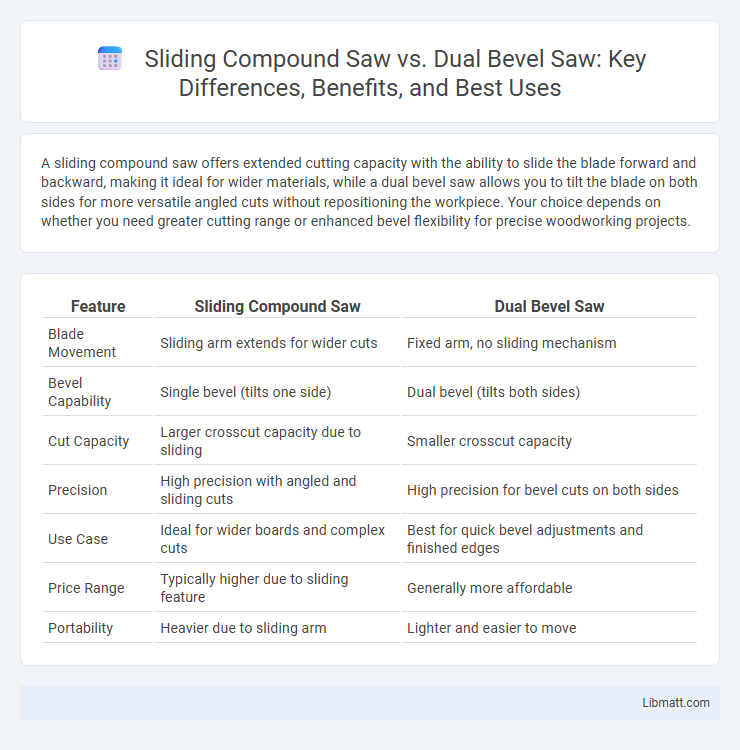A sliding compound saw offers extended cutting capacity with the ability to slide the blade forward and backward, making it ideal for wider materials, while a dual bevel saw allows you to tilt the blade on both sides for more versatile angled cuts without repositioning the workpiece. Your choice depends on whether you need greater cutting range or enhanced bevel flexibility for precise woodworking projects.
Table of Comparison
| Feature | Sliding Compound Saw | Dual Bevel Saw |
|---|---|---|
| Blade Movement | Sliding arm extends for wider cuts | Fixed arm, no sliding mechanism |
| Bevel Capability | Single bevel (tilts one side) | Dual bevel (tilts both sides) |
| Cut Capacity | Larger crosscut capacity due to sliding | Smaller crosscut capacity |
| Precision | High precision with angled and sliding cuts | High precision for bevel cuts on both sides |
| Use Case | Ideal for wider boards and complex cuts | Best for quick bevel adjustments and finished edges |
| Price Range | Typically higher due to sliding feature | Generally more affordable |
| Portability | Heavier due to sliding arm | Lighter and easier to move |
Introduction to Sliding Compound and Dual Bevel Saws
Sliding compound saws feature a sliding mechanism that extends the blade forward and backward, allowing you to cut wider boards with precision. Dual bevel saws provide adjustable blade tilting on both left and right sides, enabling angled cuts without repositioning the workpiece. Combining sliding functionality with dual bevel capabilities offers versatile cutting options for complex woodworking projects.
Key Features of Sliding Compound Saws
Sliding compound saws feature a sliding mechanism that extends the cutting capacity, enabling wider cuts on larger materials such as plywood and dimensional lumber. They combine bevel and miter adjustments, allowing precise angled cuts both vertically and horizontally, critical for complex woodworking projects. The extended rail system and powerful motors make sliding compound saws versatile tools ideal for framing, molding, and trim work.
Key Features of Dual Bevel Saws
Dual bevel saws feature the ability to tilt the blade both left and right, enabling precise angled cuts without repositioning the workpiece. These saws often include digital angle displays and powerful motors for smooth, accurate bevel cuts on materials like hardwood and plywood. Enhanced dust collection systems and adjustable fences contribute to improved safety and cutting precision compared to standard sliding compound saws.
Core Differences Between Sliding Compound and Dual Bevel Saws
A sliding compound saw features a movable arm that allows the blade to slide forward and backward, enabling it to cut wider materials compared to a stationary dual bevel saw. Dual bevel saws offer the advantage of tilting the blade both left and right, making complex angle cuts more efficient without repositioning the workpiece. Understanding these core differences helps you choose the right saw based on the types of precision cuts and material widths your projects require.
Precision and Cutting Capacity Comparison
Sliding compound saws offer enhanced cutting capacity with the ability to extend the blade forward, allowing you to cut wider materials such as large plywood sheets or thick lumber with precision. Dual bevel saws provide superior accuracy by allowing the blade to tilt both left and right without flipping the workpiece, ensuring precise angled cuts and minimizing setup time. When choosing between the two, consider that sliding compound saws optimize cutting width while dual bevel saws excel in efficiency and precision for complex bevel cuts.
Application and Best Use Cases
Sliding compound saws provide extended cutting capacity, making them ideal for larger lumber, wide boards, and framing projects requiring long rip cuts or angled cuts along the length of the wood. Dual bevel saws offer the convenience of tilting the blade both left and right without flipping the material, streamlining complex miter cuts and crown molding tasks in finish carpentry. Your choice depends on whether you need greater versatility for intricate angle cuts or extended reach for handling wider stock in woodworking applications.
Ease of Use and User Experience
Sliding compound saws offer greater flexibility with their extended cutting capacity, making it easier for users to handle wider materials without repositioning. Dual bevel saws enhance user experience by allowing bevel cuts in both directions without flipping the workpiece, saving time and effort. Your choice depends on whether ease of sliding for larger cuts or quick bevel adjustments is more important for your project workflow.
Durability and Maintenance Considerations
Sliding compound saws typically feature more complex mechanisms with rails and sliding arms, which may require regular lubrication and calibration to maintain durability and optimal performance. Dual bevel saws have fewer moving parts, leading to easier maintenance and generally longer-lasting components under consistent use. Both saw types benefit from routine blade inspections and timely replacement to ensure cutting accuracy and prolong overall tool lifespan.
Price and Value for Money
Sliding compound saws generally offer better value for money, combining affordability and versatility for everyday cutting tasks. Dual bevel saws tend to be pricier due to their advanced features, allowing simultaneous bevel cuts on both sides for increased precision. Choosing the right saw depends on your budget and specific project needs, ensuring you invest in the tool that delivers optimal performance and cost efficiency.
Which Saw is Right for You?
A sliding compound saw offers extended cutting capacity with its adjustable sliding rails, ideal for larger materials and wide crosscuts, while a dual bevel saw provides precise angle adjustments on both sides without repositioning the workpiece, perfect for intricate bevel cuts. Choose a sliding compound saw if you frequently work on big projects requiring long, straight cuts and versatility. Opt for a dual bevel saw for detailed woodworking tasks needing high precision and efficiency in bevel adjustments.
Sliding compound saw vs dual bevel saw Infographic

 libmatt.com
libmatt.com